Learn about purchasing for teams

Over the past few years, agile in the marketing context has increasingly become an integral part of the conversation among marketing leaders. The benefits of implementing the agile methodology have spread beyond just software development and made their way into the marketing and sales departments of our organizations. As a result, more and more marketing execution teams are adopting agile practices to increase organizational alignment, establish a faster pace of delivery, and boost campaign quality.
This past January, AgileSherpas partnered with Aprimo to collect data from more than 600 marketers about their process practices and how they are using (or not using) agile practices in their daily work. Even though our most recent research on the State of Agile Marketing was conducted before COVID-19 was declared a pandemic, it confirms marketers’ gradual move towards more agile ways of working that was substantially accelerated by the change in the global environment.
Few could have predicted that the need for agility in the marketing function would become as “do or die” as it has in the past few months. The series of economic events surrounding the worldwide reaction to the pandemic have shown that without an agile approach in place, marketers–not to mention entire organizations–could face extinction.
Since the beginning of the year, marketing leaders and teams alike now understand that agility is linked not just to business success but to business survival.
A number of key takeaways from this year’s findings show that marketers are making their way toward the peak of marketing agility, despite the challenges along the way.
A First: Agile Marketers Outnumber All Other Groups
For the first time in the history of the report, the number of marketers who labeled themselves as agile surpassed the number of traditional or ad hoc marketers.
According to our statistics, 42 percent of marketers are using at least some parts of an agile marketing approach to manage their work. Fewer marketers are sticking to traditional methods for getting their work done; instead, they’re aiming for more flexible and adaptive plans that allow them to capitalize on emerging opportunities.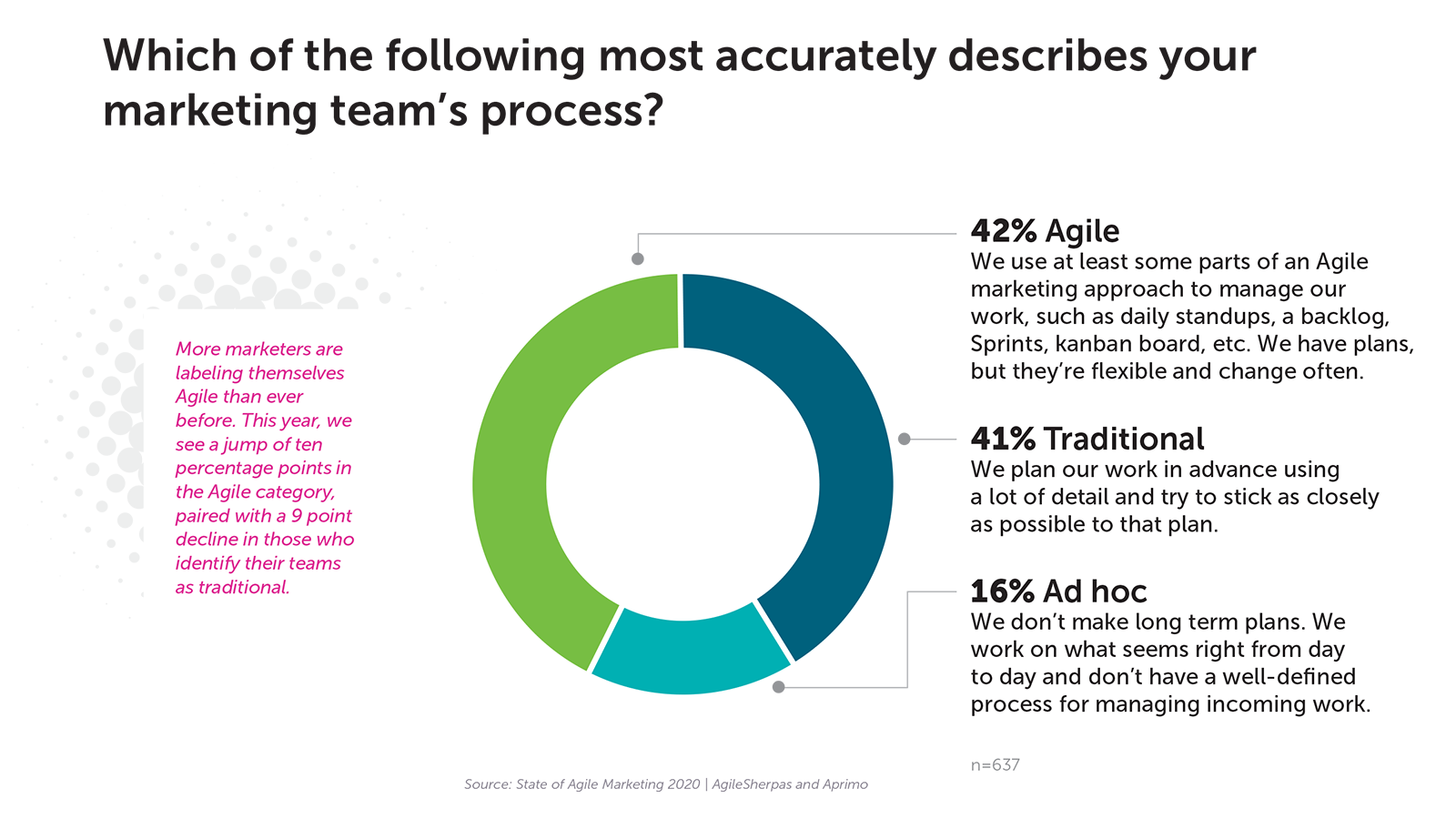
The most common agile practices in use within marketing departments include daily standups, user stories, retrospectives, frequent releases, and digital kanban boards. Compared to 2019, many more marketers are adopting these tried and tested agile techniques for business success.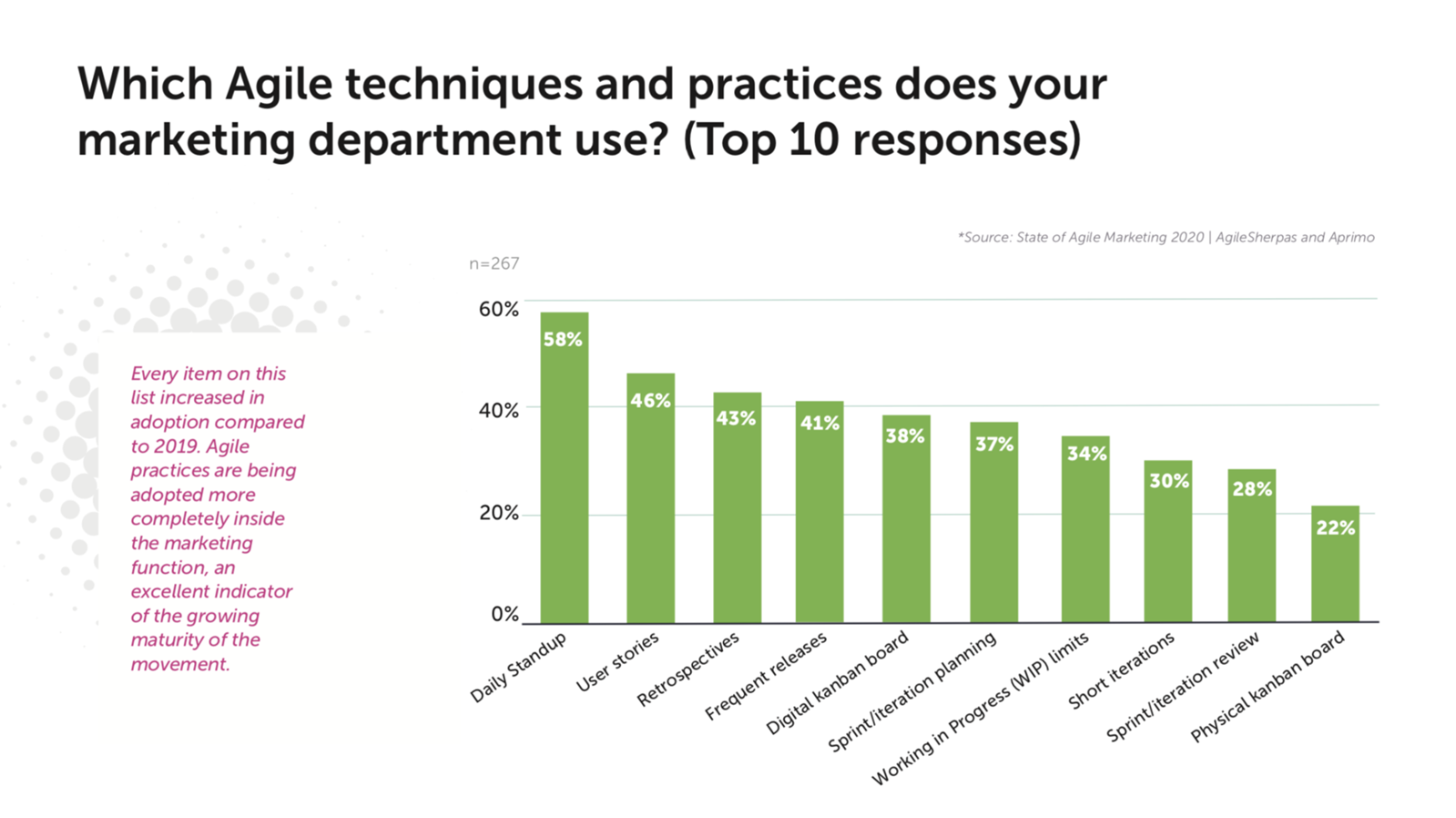
Marketers experimenting with agile ways of working have allies all across the organization. Forty-nine percent of marketers say that the IT/software development functions within their organizations are also using aspects of agile methodology. For new agile marketing teams, advice from experienced agile practitioners, like software developers, can be very advantageous in the long-term.
Another adjacent group to marketing, commonly cited as a fellow agile function, is the sales department. Fifty-two percent of marketers say the sales team at their company is also applying agile.
As fellows in the realm of business agility, marketing and sales could work together to adopt business agility more completely in their part of the business.
A Happy Surprise: Marketing Agility Brings a Lot More Than Just Speed
While a general misconception persists about agile ways of working leading up to just a sense of “going faster,” marketers recognize and turn to agile for its even more significant benefits.
Among the top reasons why marketers turn to agile include their desire to:
- improve productivity
- enhance their ability to manage changing priorities
- increase innovation in their departments
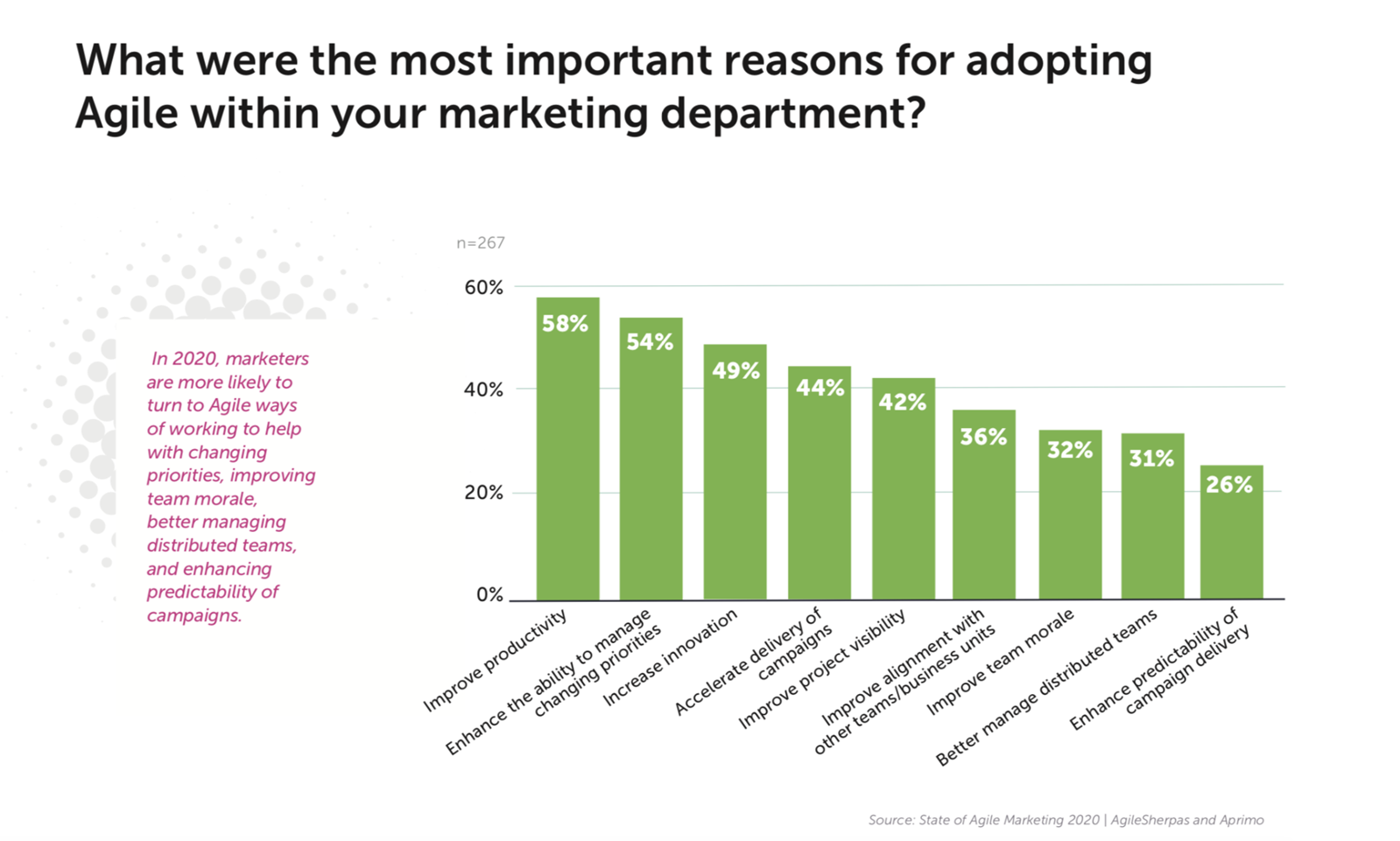 So far, agility has been able to deliver on these expectations in addition to helping marketers deliver their campaigns to customers faster. Even though many marketing teams consider themselves novices when it comes to agile methodology and practices, they are already able to experience some of agile’s much sought-after benefits.
So far, agility has been able to deliver on these expectations in addition to helping marketers deliver their campaigns to customers faster. Even though many marketing teams consider themselves novices when it comes to agile methodology and practices, they are already able to experience some of agile’s much sought-after benefits.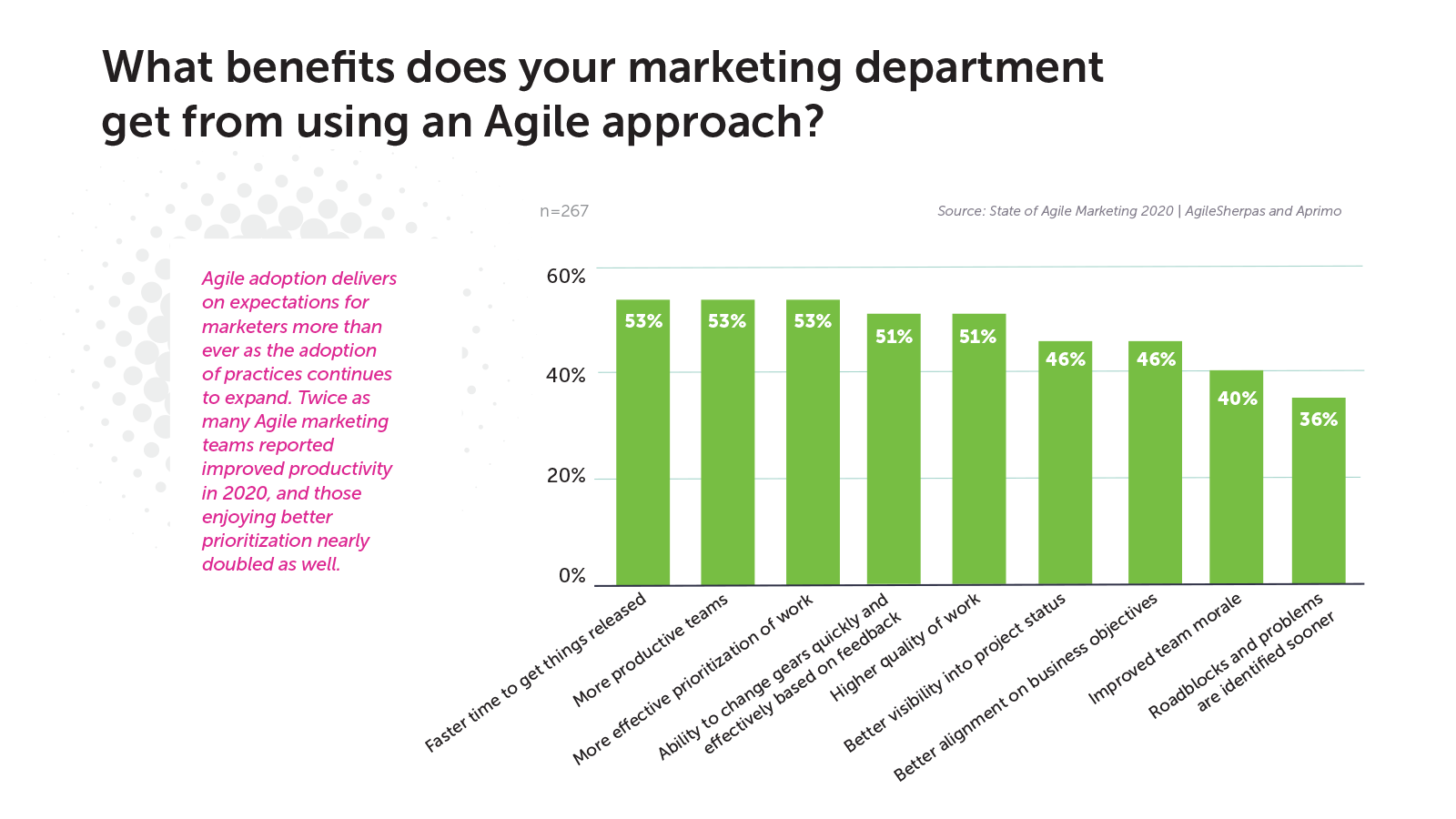 Large percentages of the marketers queried see higher levels of productivity, better prioritization, ability to change gears based on feedback, and boosts in speed and quality of their deliverables.
Large percentages of the marketers queried see higher levels of productivity, better prioritization, ability to change gears based on feedback, and boosts in speed and quality of their deliverables.
A Word of Caution: Barriers to Agile Marketing Adoption Persist
Despite a clear trend towards more agile marketing departments in the future, the journey towards agility is not without its challenges. Specifically, marketers cite a lack of training and knowledge about agile practices, the perception that current processes are working “well enough,” not having the right talent in their teams, and the lack of access to the right tools as reasons their departments cannot implement an agile approach more completely.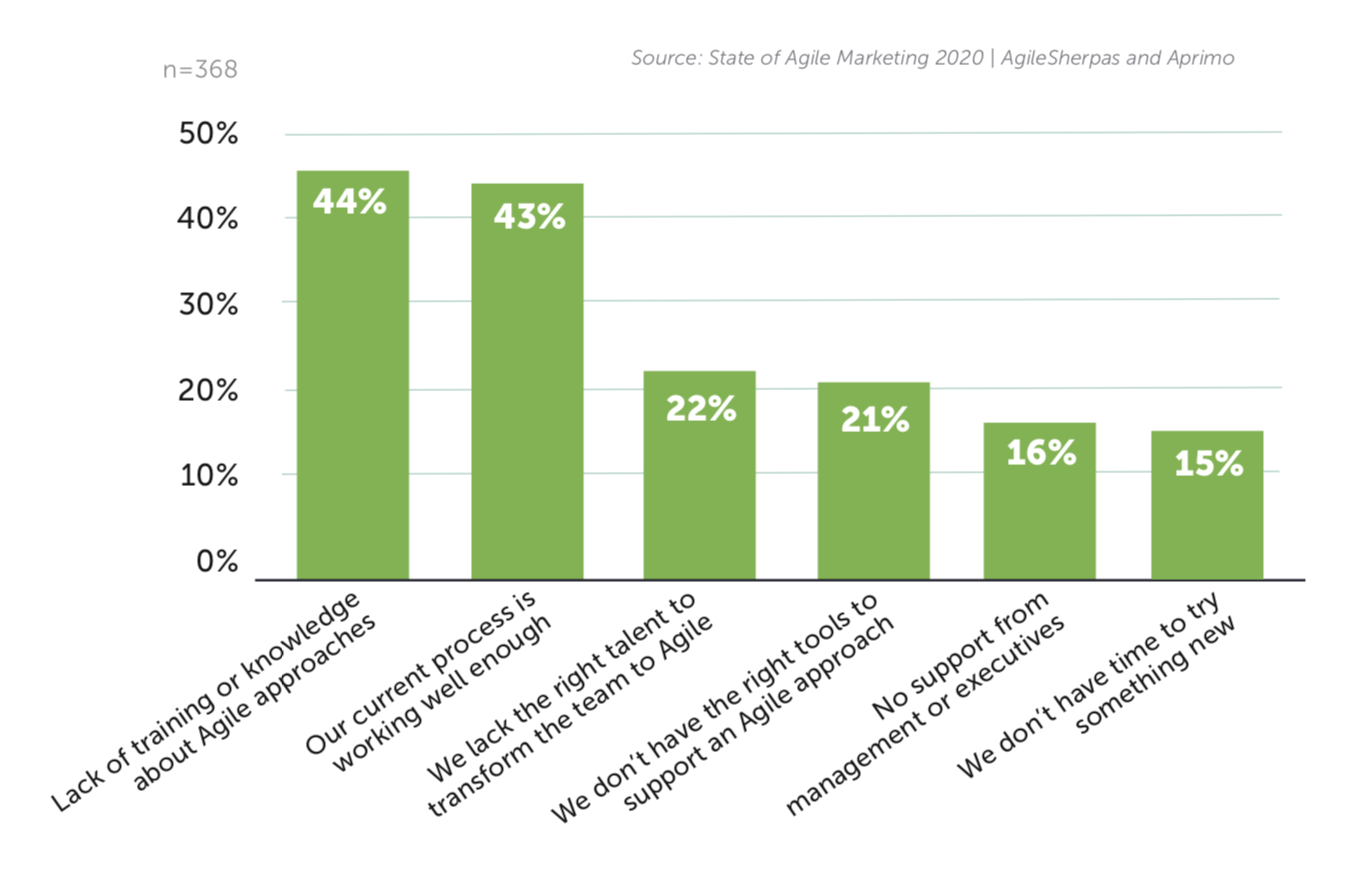
“Lack of training or knowledge about agile approaches,” cited by 44 percent of marketers queried for the report, is leading the top reasons why marketers are not going agile in 2020. Consequently, education in this area is becoming more of a priority for marketing leaders this year.
Getting marketers agile training specific to their area of expertise will not only help them overcome this big barrier to adoption, it will also serve their entire team as they mature into agilists together.
Additionally, data from 2019 showed that many marketers blamed their delay in agile adoption on not having the right tools. Statistics from 2020 indicate that three times as many marketers as last year felt that lack of proper tools was holding them back from going agile.
A Hint About The Future: Non-Agile Marketing Departments Plan to Implement Agility in the Coming Year
Fortunately, no barrier to agile adoption from those cited in the report will be insurmountable for marketing departments that are still traditional and ad hoc.
Forty-six percent of marketers queried in January said they plan to go agile within the next six months. Forty-nine percent are planning to shift to agile ways of working within the year.
These statistics show that even before the pandemic hit, interest in agile marketing among those not already using it was high. However, since this sudden change of circumstances, the sense of urgency to adopt agile has absolutely skyrocketed.
These times of VUCA truly put agile to the test. Many marketing teams were forced to go agile as soon as possible in order to deal with travel bans, potential customer drops in income, widespread anxiety, and the need to social distance.
Every day, there’s a new article about a marketing department that needed to adopt agile overnight in order to continue reaching customers as they themselves dealt with changing circumstances.
The verdict? Agile is helping marketers stay afloat, remain flexible, and adapt to survive at a time when all our plans seem to be up in the air.
Agile Marketing "For the Win" in 2020
By helping marketers weather the social and economic storm of the current pandemic, agile marketing is proving that it is not just a buzzword. In fact, the most recent data from the 3rd Annual State of Agile Marketing Report shows that agile is becoming a pillar that marketers can lean on strategically.
Non-agile marketers, who are just learning about agile ways of working, are in a great position to pursue agile adoption in 2020. Strong allies in sales and software development, an overall better understanding of the benefits of agility, and good company in the form of 42 percent of marketers who are already agile mean that traditional and ad hoc marketing teams are poised for an accelerated agile revolution this year.
Related Artilce: How Scrum Alliance Creates High-Performing Content
Create marketing teams that adapt and deliver
Learn how to plan smarter, collaborate better, and respond to change with confidence. The Agile for Marketing microcredential helps you apply agile principles to your daily work so campaigns stay creative, focused, and effective.










